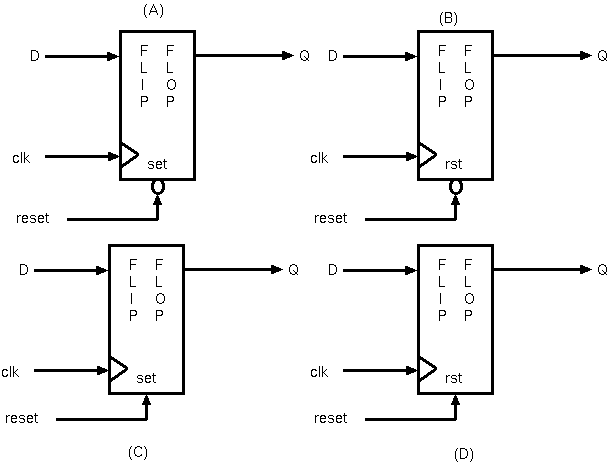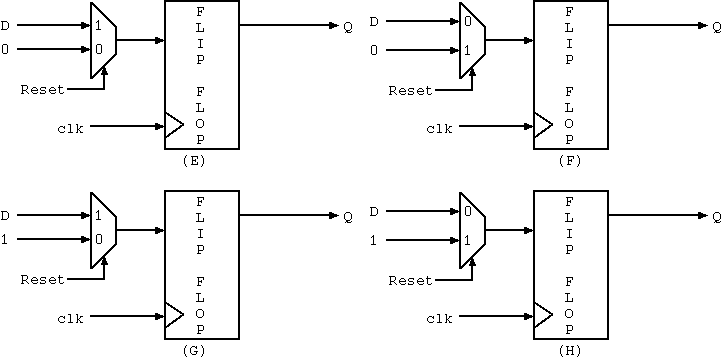Important Concepts
:- What are flip flops, registers and latches? how do we avoid latches?
- What are what are counters and shift registers?
- How to make a register or a wire with a signal and VHDL?
- What is debouncing? How to use buttons on FPGA board and mitigate debouncing?
Exercise Questions
- Fill the correct diagrams and Codes in the table
| Diagram | Code | |
| Dflipflop with asynchronous negetive Reset to 1 | Figure(_________) | Code(_________) |
| Dflipflop with asynchronous negetive Reset to 0 | Figure(_________) | Code(_________) |
| Dflipflop with asynchronous postive Reset to 1 | Figure(_________) | Code(_________) |
| Dflipflop with asynchronous postive Reset to 0 | Figure(_________) | Code(_________) |
| Dflipflop with synchronous negetive Reset to 0 | Figure(_________) | Code(_________) |
| Dflipflop with synchronous positive Reset to 0 | Figure(_________) | Code(_________) |
| Dflipflop with synchronous negetive Reset to 0 | Figure(_________) | Code(_________) |
| Dflipflop with synchronous positive Reset to 0 | Figure(_________) | Code(_________) |


- Code(1)
signal d,clk,q,reset :std_logic; process(clk,d) begin if (clk’event and clk=’1’) then if reset = '1' then q <= '0'; else q <= d; end if; end if; end process;
- Code (2)
signal d,clk,q,reset :std_logic; process(clk,d) begin if (clk’event and clk=’1’) then if reset = '1' then q <= '1'; else q <= d; end if; end if; end process;
- Code (3)
signal d,clk,q,reset :std_logic; process(clk,d) begin if (clk’event and clk=’1’) then if reset = '0' then q <= '0'; else q <= d; end if; end if; end process;
- Code (4)
signal d,clk,q,reset :std_logic; process(clk,d) begin if (clk’event and clk=’1’) then if reset = '0' then q <= '1'; else q <= d; end if; end if; end process;
- Code (5)
signal d,clk,q,reset :std_logic; process(clk,d) begin if reset = '1' then q <= '0'; elsif (clk’event and clk=’1’) then q <= d; end if; end process;
- Code (6)
signal d,clk,q,reset :std_logic; process(clk,d) begin if reset = '1' then q <='1'; elsif (clk’event and clk=’1’) then q <= d; end if; end process;
- Code (7)
signal d,clk,q,reset :std_logic; process(clk,d) begin if reset = '0' then q <='0'; elsif (clk’event and clk=’1’) then q <= d; end if; end process;
- Code (8)
signal d,clk,q,reset :std_logic; process(clk,d) begin if reset = '0' then q <= '1'; elsif (clk’event and clk=’1’) then q <= d; end if; end process;
| ### | REGISTER WITH COMBINATIONAL CIRCUIT | LATCH WITH COMBINATIONAL CIRCUIT | ONLY COMBINATIONAL CIRCUIT | Description of the resulting design |
| Code 1 | yes(_____)/No(_____) | yes(_____)/No(_____) | yes(_____)/No(_____) | |
| Code 2 | yes(_____)/No(_____) | yes(_____)/No(_____) | yes(_____)/No(_____) | |
| Code 3 | yes(_____)/No(_____) | yes(_____)/No(_____) | yes(_____)/No(_____) | |
| Code 4 | yes(_____)/No(_____) | yes(_____)/No(_____) | yes(_____)/No(_____) | |
| Code 5 | yes(_____)/No(_____) | yes(_____)/No(_____) | yes(_____)/No(_____) | |
| Code 6 | yes(_____)/No(_____) | yes(_____)/No(_____) | yes(_____)/No(_____) |
- Code 1
signal c,a,b,select,clk :std_logic; process(clk,a,b,select) begin if (clk’event and clk=’1’) then if select = '1' then c <= a and b; else c <= a or b; end if; end if; end process;
- Code 2
signal c,a,b,select,clk :std_logic; process(clk,a,b,select) begin if (clk’event and clk=’1’) then if select = '1' then c <= a and b; end if; end if; end process;
- Code 3
signal c,a,b,select :std_logic; process(a,b,select) begin if select = '1' then c <= a and b; end if; end process;
- Code 4
signal c,a,b,clk :std_logic; process(clk,a,b) begin if (clk=’1’) then c <= a and b; end if; end process;
- Code 5
signal c,a,b,clk :std_logic; process(clk,a,b) begin c <= a or b; if (clk=’1’) then c <= a and b; end if; end process;
- Code 6
signal c,a,b,clk :std_logic; process(clk,a,b) begin if (clk=’1’) then c <= a and b; else c <= a or b; end if; end process;
| -- | Shift Register | Description the design |
| Code 1 | yes(_____)/No(_____) | - |
| Code 2 | yes(_____)/No(_____) | - |
| Code 3 | yes(_____)/No(_____) | - |
| Code 4 | yes(_____)/No(_____) | - |
- Code 1
signal s0,s1,s2,s3,clk :std_logic; process(clk,s1,s2,s0) begin if (clk’event and clk=’1’) then s1 <= s0; s2 <= s1; s3 <= s2; end if; end process;
- Code 2
signal clk :std_logic; process(clk,s1,s2,s0) variable s0,s1,s2,s3 :std_logic; begin if (clk’event and clk=’1’) then s1 := s0; s2 := s1; s3 := s2; end if; end process;
- Code 3
signal clk :std_logic; process(clk,s1,s2,s0) variable s0,s1,s2,s3 :std_logic; begin if (clk’event and clk=’1’) then s3 := s2; s2 := s1; s1 := s0; end if; end process;
- Code 4
signal s0,s1,s2,s3 :std_logic; process(S0,s1,s2) begin s1 <= s0; s2 <= s1; s3 <= s2; end process;